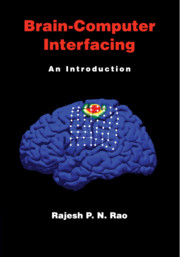Preface
Published online by Cambridge University Press: 05 October 2013
Summary
Preface
“Scientists demo thought-controlled robots”
(PC Magazine, July 9, 2012)“Bionic vision: Amazing new eye chip helps two blind Brits to see again”
(Mirror, May 3, 2012)“Paralyzed, moving a robot with their minds”
(New York Times, May 16, 2012)“Stephen Hawking trials device that reads his mind”
(New Scientist, July 12, 2012)These headlines, from just a few weeks of news stories in 2012, illustrate the growing fascination of the media and the public with the idea of interfacing minds with machines. What is not clear amid all this hype is: (a) What exactly can and cannot be achieved with current brain-computer interfaces (BCIs) (sometimes also called brain-machine interfaces or BMIs)? (b) What techniques and advances in neuroscience and computing are making these BCIs possible? (c) What are the available types of BCIs? and (d) What are their applications and ethical implications? The goal of this book is to answer these questions and provide the reader with a working knowledge of BCIs and BCI techniques.
Information
- Type
- Chapter
- Information
- Brain-Computer InterfacingAn Introduction, pp. xiii - xviPublisher: Cambridge University PressPrint publication year: 2013
